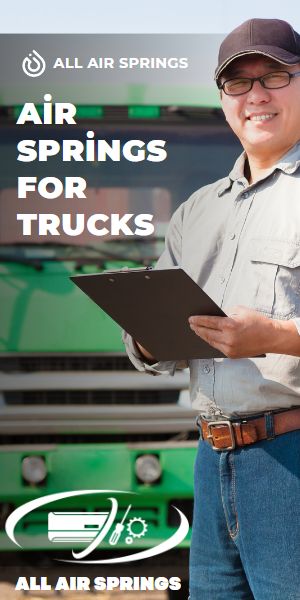
Everything You Need to Know About Cabin Air Springs: Benefits, Maintenance, and More
Introduction to Cabin Air Springs
Cabin air springs are an essential part of modern vehicle suspension systems, designed to enhance the comfort and safety of your ride. These air springs are installed in a vehicle’s cabin, providing a cushion that adjusts to changes in load and driving conditions. They consist of an inflatable air bladder, which can adjust its pressure depending on the weight the vehicle is carrying, creating a smoother, more controlled ride.
In addition to offering comfort, cabin air springs help in noise reduction by dampening vibrations from the road. By absorbing shocks and providing consistent suspension, they reduce the impact of bumpy roads and uneven surfaces on the cabin.
Over the years, cabin air springs have become increasingly important, particularly in luxury and high-performance vehicles. They enable a much more comfortable driving experience by adapting to different load conditions, road surfaces, and driving speeds, ensuring that passengers experience minimal discomfort. Additionally, cabin air springs contribute to overall vehicle stability, improving both safety and performance.
How Cabin Air Springs Work
Cabin air springs work by using compressed air to create a cushion between the vehicle’s suspension and the cabin, effectively reducing the impact of road irregularities. The system includes an air bladder, a compressor, and sensors that work together to maintain the optimal air pressure.
The air bladder, typically made of durable rubber, is inflated or deflated based on the weight and load distribution within the vehicle. When a vehicle is heavily loaded, the air springs inflate to support the added weight, keeping the ride height level and comfortable. Conversely, when the load is lighter, the air springs deflate, maintaining an even ride height without unnecessary stiffness.
Air pressure is regulated by a compressor, which can automatically adjust the inflation levels based on real-time road conditions and the vehicle’s load. Sensors monitor the ride height, ensuring that the vehicle maintains a smooth, stable ride at all times. This dynamic adjustment ensures that cabin air springs provide optimal suspension performance for various driving conditions.
By absorbing shocks from bumps and dips in the road, cabin air springs prevent excessive bouncing, reduce cabin noise, and enhance the overall driving experience. This technology is especially beneficial in vehicles that frequently carry varying loads, such as trucks, SUVs, and high-end luxury cars.
Benefits of Cabin Air Springs
Cabin air springs provide a variety of benefits that greatly improve the driving experience, making them a valuable component in modern vehicles.
Enhanced Comfort
One of the primary advantages of cabin air springs is the significant improvement in comfort. These air springs adjust to the weight distribution in the vehicle, ensuring that the ride remains smooth regardless of road conditions or load. By absorbing shocks and vibrations, they reduce the feeling of bumps and jolts, providing a more stable and comfortable ride. This is particularly beneficial on long trips or when driving on rough or uneven terrain.
Improved Safety
Cabin air springs also play a crucial role in vehicle safety. They help maintain the proper ride height, which is essential for vehicle stability. In the event of heavy loads or uneven weight distribution, air springs help keep the vehicle balanced, preventing excessive sway or instability. By ensuring that the vehicle maintains its optimal height and alignment, cabin air springs contribute to safer handling, especially when cornering or driving at higher speeds.
In addition, by reducing the impact of road irregularities and distributing weight evenly, cabin air springs reduce wear and tear on other suspension components, leading to fewer maintenance issues and longer vehicle lifespan.
Types of Cabin Air Springs
Cabin air springs come in various types, each designed to meet different needs depending on the vehicle and its intended use. Understanding the different options available can help you choose the best solution for your vehicle.
Standard vs. Advanced Systems
There are two main categories of cabin air springs: standard systems and advanced systems. Standard air springs are typically found in vehicles with basic suspension setups, offering good comfort and shock absorption. These systems generally use simpler air bladders and a basic compressor to adjust to load variations. They are ideal for standard passenger vehicles and provide a noticeable improvement over traditional coil springs.
On the other hand, advanced systems are often found in high-end luxury cars, trucks, or commercial vehicles that require more precise suspension control. These systems feature more sophisticated sensors and compressors, allowing for real-time adjustments based on road conditions and load. Advanced air springs provide superior ride quality, stability, and handling, particularly in vehicles that frequently carry heavy loads or operate in challenging environments.
Customization for Different Vehicles
Cabin air springs can be tailored to fit various vehicle types, including cars, SUVs, trucks, and buses. Each type of vehicle requires specific air spring configurations based on its weight, suspension design, and intended use. For instance, larger vehicles like trucks often require more robust and durable air springs to handle heavier loads, while smaller vehicles may use less complex systems for improved comfort.
Customizing cabin air springs ensures that the vehicle’s suspension system operates at optimal performance, providing the right balance between comfort and stability for each specific application. This customization allows manufacturers and aftermarket suppliers to offer tailored solutions that best suit the needs of drivers, whether for daily commuting or specialized commercial uses.
Signs Your Cabin Air Springs Need Replacement
Cabin air springs are designed to last for many years, but like all vehicle components, they can eventually wear out. Recognizing the signs that your cabin air springs need replacement can help you avoid uncomfortable or unsafe driving conditions. Here are some common symptoms to watch out for:
Common Symptoms
-
Uneven Ride Height
: One of the first signs that your cabin air springs may be failing is uneven ride height. If the vehicle sits too low on one side or sags in the rear, it may indicate that one or more air springs are no longer functioning properly.
- Bouncy or Rough Ride: If you notice that the ride becomes unusually bouncy or harsh, especially after hitting bumps or dips in the road, it could be a sign that your air springs are no longer absorbing shocks effectively.
- Air Leaks: If you hear a hissing sound or notice a loss of air pressure, this could indicate an air leak in the system. This often happens due to a tear or crack in the rubber bladder, which requires immediate attention.
How to Diagnose Issues
If you notice any of the above symptoms, it’s important to inspect the air springs as soon as possible. Start by visually checking for any signs of damage or visible wear, such as cracks, bulges, or cuts in the rubber. You can also check the air pressure manually with a pressure gauge to see if it is within the recommended range.
If you are not confident in diagnosing the issue yourself, it’s a good idea to have a professional mechanic inspect the air springs. Regular maintenance and early detection of issues can prevent further damage to the suspension system and ensure a smoother, safer ride.
Maintenance Tips for Prolonging Cabin Air Springs
Proper maintenance is crucial for ensuring that your cabin air springs continue to perform effectively and last as long as possible. Regular care can prevent premature wear and costly repairs. Here are some essential maintenance tips to help extend the lifespan of your cabin air springs:
Routine Inspections
Regular inspections are vital to ensure that your cabin air springs are functioning properly. At least once a year, have a professional mechanic check the air springs for any signs of damage, leaks, or wear. During an inspection, the technician will assess the condition of the rubber bladder, the air pressure, and the overall performance of the air springs. Early detection of issues can help prevent more serious damage down the road.
Proper Load Management
One of the main causes of premature wear on cabin air springs is overloading. While air springs are designed to handle varying loads, consistently carrying heavy loads beyond the vehicle’s capacity can cause the air springs to wear out faster. Ensure that your vehicle is never overloaded, and always distribute the weight evenly across the suspension. This will help maintain the air springs’ integrity and ensure they function optimally.
Additionally, maintaining proper tire pressure is essential for the overall health of your vehicle’s suspension system, including the air springs. Tires that are either under- or over-inflated can place additional stress on the air springs, leading to quicker wear.
By incorporating these simple maintenance habits, you can maximize the lifespan of your cabin air springs and enjoy a smoother, more comfortable ride for years to come.
Choosing the Right Cabin Air Springs
Selecting the right cabin air springs is crucial for ensuring that your vehicle’s suspension system works efficiently and provides the best driving experience. Here are some tips on how to choose the perfect cabin air springs for your vehicle:
Compatibility with Your Vehicle
The most important factor when choosing cabin air springs is ensuring that they are compatible with your vehicle’s make and model. Air springs come in various sizes and configurations, so it’s essential to check the specifications provided by the manufacturer. Choosing the wrong size or type of air spring can lead to poor performance, uneven ride height, and increased wear on other suspension components.
To make sure you get the right fit, consult your vehicle’s manual or seek advice from a trusted mechanic or air spring supplier. Many air spring manufacturers provide compatibility charts or can guide you in selecting the best option for your vehicle.
Quality vs. Price
While it may be tempting to opt for cheaper air springs to save on costs, it’s important to balance affordability with quality. High-quality air springs typically offer better durability, improved performance, and longer lifespan compared to cheaper, lower-quality alternatives. Investing in a reputable brand will ensure that your vehicle’s suspension system remains reliable and effective for years to come.
In addition to quality, consider factors like warranty and customer reviews when making your decision. A well-established brand with a good reputation is more likely to provide reliable products and customer support.
By carefully selecting the right cabin air springs, you can ensure a smoother ride, improved vehicle performance, and long-lasting suspension system.
Conclusion: Investing in Cabin Air Springs
Cabin air springs are a valuable investment for anyone looking to enhance their vehicle’s comfort, safety, and overall performance. By providing a smoother ride, better load management, and improved stability, they make a significant difference, especially for vehicles that carry heavy loads or operate in challenging driving conditions.
Long-Term Value
Investing in high-quality cabin air springs not only improves the driving experience but also contributes to the longevity of your vehicle. Properly functioning air springs can extend the life of your suspension system, prevent unnecessary wear on other parts, and reduce the need for frequent repairs. This long-term value makes cabin air springs a smart choice for vehicle owners who want a balance of performance, comfort, and cost-effectiveness.
Future Trends in Air Spring Technology
As automotive technology continues to advance, so too does the development of cabin air springs. Future trends may include even more efficient and adaptive air spring systems, incorporating advanced sensors and artificial intelligence for real-time adjustments based on road conditions and driving style. These innovations will further enhance ride quality and vehicle stability, ensuring that cabin air springs remain a crucial component in modern vehicles.
In conclusion, whether you’re looking to upgrade your vehicle’s suspension for improved comfort or safety, investing in quality cabin air springs will undoubtedly pay off. They provide exceptional value, offering an adaptable and reliable solution for a smoother, safer ride.
For detailed information, you can contact us at torqueusa.com


